#Vickers Armstrong
Explore tagged Tumblr posts
Text

The Lightning's range wasn't... great. Presumably this one needed a top-up from that Victor mid-interception!
@Tempest_books via X
#lightning#english electric aviation#interceptor#tu 95#tupolev aviation#bomber#reconnaissance#soviet aircraft#k.2 Victor#vickers Armstrong#tanker#aircraft#aviation#cold war aircraft#raf
28 notes
·
View notes
Text
Uzi listens to power metal, specifically Sabaton, DragonForce, and Twilight Force.

#Murder Drones#Liam Vickers Animation#Glitch Productions#Murder Drones Headcanon#Metal Gear#Metal Gear Rising#Metal Gear Rising Revengeance#Max0r#Power Metal#Sabaton#DragonForce#Twilight Force#Uzi Doorman#Murder Drones Uzi#Senator Armstrong#It's almost been two weeks since E7 and my drafts are STILL clogged with MD stuff to reblog#Probably gonna have to start bookmarking posts and go back to them later#Or wait until the tag breaks again and won't show any new posts for a while#'Cuz what I'm doing right now got me feeling like Sisyphus#Straight From the Dragon's Mouth
54 notes
·
View notes
Text
The link between warfare and technological innovation has been well documented [...]. World War II was a particularly intense crucible of technological change, and the repurposing of military technologies and industries in the forging of a new post-war consumer [economy] is crucial [...]. Processes of technological bricolage turned the machines of war onto the natural world as global powers competed to cement their economic and imperial hegemony. In Great Britain’s post-war “groundnut scheme” in its East African territories (1946-51), this collision of nature, military hardware, and technical expertise was part of efforts to both produce more fats for the British diet and to demonstrate to the world (most importantly the United States) that, through a newly energized science-led developmentalism, British colonialism still had a “progressive” role to play in the postwar world.

The aim was to produce millions of tons of peanuts across Tanganyika using the latest methods of advanced scientific agriculture. The environmental conditions in the north, where the scheme was to begin, were known to be especially trying, not least the dry climate [...]. But faith in the power of mechanized agriculture was such that any natural limits were thought to be readily surmountable.
The groundnut scheme was to be, as its Director put it in an interview with the Tanganyika Standard, a “war” with nature, and an “economic Battle of Alamein” waged over some three million acres by an army of colonial technicians - many recruited from military ranks - and local laborers, for many of whom the scheme represented their first entry into the wage labor market.
But it wasn’t just the rhetoric of war that was repurposed.
Lancaster bombers were kitted out to survey and discover “new country” in East Africa for agricultural development. [...] [T]ractors and bulldozers from military surplus stores in Egypt proved unable to tackle the hard ground and tough vegetation, so the planners turned to a novel solution: repurposing surplus Sherman M4A2 tanks. The Vickers-Armstrong factory in Newcastle-Upon-Tyne set about rearranging key elements of the tanks’ construction [...]. The tractors, christened “Shervicks” for their hybrid origins, were [...] thought to be particularly suited to large-scale earth-moving and to the kind of heavy duty “bush clearing” that was required in Tanganyika.
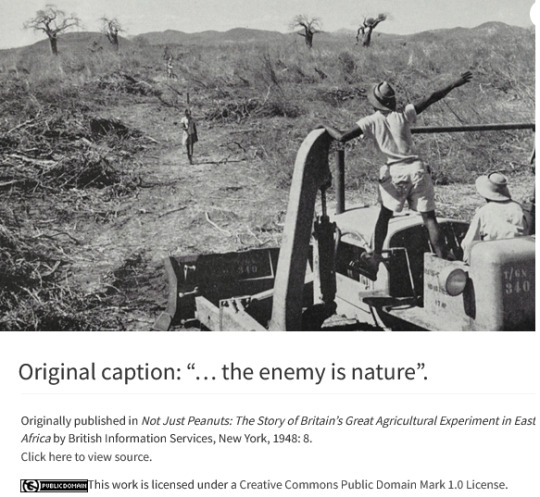
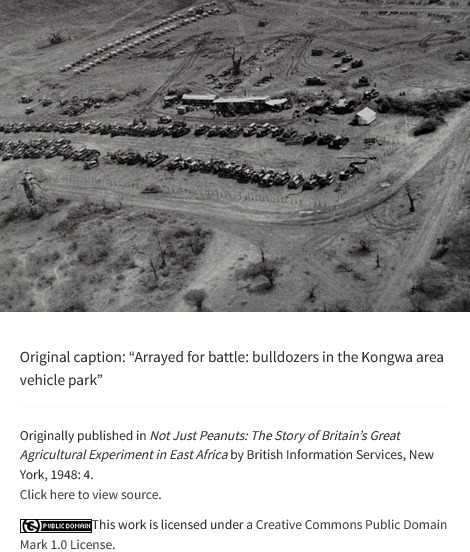
Officials sought to dismiss concerns that large-scale bush clearing would have wider environmental consequences, using the well-worn colonial trope that any observed changes in local climate or erosion patterns were due to the “primitive” agricultural practices of the locals, not to the earth-moving practices of the colonists. [...] As the plants continued to wilt in the sun, [...] [t]he stakes were high. As [J.R.] of the Colonial Development Corporation put it in a letter: “Our standing as an Imperial power in Africa is to a substantial extent bound up with the future of this scheme. To abandon it would be a humiliating blow to our prestige everywhere.” The only option left was to try and bend the weather itself to the scheme’s will, by seeding the clouds for rain. [...] “Balloon bombs” (photographic film canisters tethered to weather balloons) and a repurposed Royal Navy flare gun were used to target individual clouds [...]. The scheme itself has survived as a cautionary tale of governmental hubris, but it is instructive too as a case study of how technologies of war have been turned against other foes.
---
All text above by: Martin Mahony. “The Enemy is Nature: Military Machines and Technological Bricolage in Britain’s ‘Great Agricultural Experiment.’“ Environment and Society Portal, Arcadia (Spring 2021), no. 11. Rachel Carson Center for Environment and Society. doi:10.5282/rcc/9191. [Bold emphasis and some paragraph breaks/contractions added by me. Images and their captions are shown unaltered as they originally appear in Mahony's article. Public Domain Mark 1.0 License for images: creativecommons dot org/publicdomain/mark/1.0/]
195 notes
·
View notes
Text
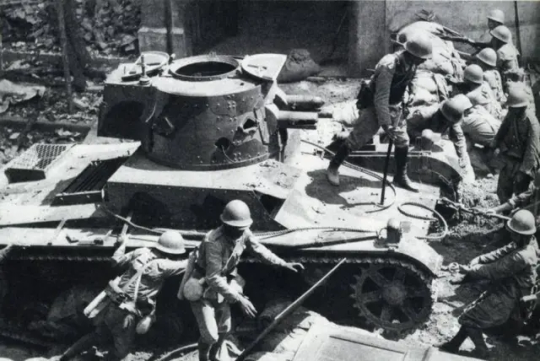
Japanese Army soldiers tow a disabled Chinese Vickers Armstrong 6-ton tank from the battlefield to their territory. The operation is led by an officer standing on the front armor plate.
19 notes
·
View notes
Text

Lancaster PA474 at RAF Coningsby, England
The Avro Lancaster is the most famous and successful RAF heavy bomber of World War Two.
There are only two airworthy Lancasters left in the world - 7,377 were built.
Lancaster PA474 was built at the Vickers Armstrong Broughton factory at Hawarden Airfield, Chester, on 31 May 1945, just after VE day. The war in the Far East ended before she was deployed and she did not take part in any hostilities.
#RAF#Avro Lancaster#WW2 Bomber#Vintage aircraft#Iconic aircraft#Heavy bomber#Lanc#aviation#airplane#plane
90 notes
·
View notes
Text






In 1934 Vickers-Armstrong had produced a new medium tank, the A9, which was subsequently designated the Cruiser Tank Mark I. The Cruiser was an effective tank in the French and early North African campaigns. The 2 pdr gun was lethal against the early Italian tanks encountered during the North African campaign and could hold its own against early Panzers.
The mechanical unreliability of the Cruiser was also a disadvantage. A9s equipped some regiments of the 1st Armored Division in France until the time of the Dunkirk withdrawal in June 1940. They were also used by regiments in the Western Desert until 1941.
8 notes
·
View notes
Text

The word “great” is somewhat promiscuously applied to actors. But it was undoubtedly deserved by Sir Michael Gambon, who has died aged 82 after suffering from pneumonia.
He had weight, presence, authority, vocal power and a chameleon-like ability to reinvent himself from one role to another. He was a natural for heavyweight classic roles such as Lear and Othello. But what was truly remarkable was Gambon’s interpretative skill in the work of the best contemporary dramatists, including Harold Pinter, Alan Ayckbourn, David Hare, Caryl Churchill and Simon Gray.
Although he was a fine TV and film actor – and forever identified in the popular imagination with Professor Albus Dumbledore in the Harry Potter franchise – the stage was his natural territory. It is also no accident that, in his private life, Gambon was an expert on, and assiduous collector of, machine tools and firearms for, as Peter Hall once said: “Fate gave him genius but he uses it as a craftsman.”
Off-stage, he was also a larger-than-life figure and a superb raconteur: a kind of green-room Falstaff. I have fond memories of an evening in a Turin restaurant in March 2006 on the eve of Pinter’s acceptance of the European Theatre prize. Gambon kept the table in a constant roar, not least with his oft-told tale of auditioning for Laurence Olivier as a young actor in 1963 and cheekily choosing to do a speech from Richard III; but the next night Gambon gave an explosive rendering of Pinter’s poem American Football that threatened to blow the roof off the Turin theatre.
However, Gambon’s bravura was also mixed with a certain modesty. In the summer of 2008 I met him for tea in London and found him eagerly studying the script of Pinter’s No Man’s Land, in which he was scheduled, several months later, to play Hirst. He told me that he had started work on it so soon because he found it difficult to learn lines at his age.
“Sometimes,” he said, “I sleep with a script under my pillow, or just carry it around in my raincoat pocket, in the hope the lines will rub off on me.” I think he was genuine; but with Gambon, one of life’s great leg-pullers, you were never entirely sure.
Gambon achieved greatness without either the formal training or genetic inheritance that are often considered indispensable.
He was born into a working-class Dublin family that had no artistic background; his mother, Mary (nee Hoare), was a seamstress, and his father, Edward, an engineer. When the family settled in Britain after the second world war, the young Gambon went to St Aloysius school for boys, in Somers Town, central London. On leaving at the age of 15 he signed a five-year apprenticeship with Vickers-Armstrongs, leading to a job as a tool-and-die maker. With his mechanical aptitude, he loved the work. But he also discovered a passion for amateur theatre and, having started by building sets, eventually moved into performing. “I want varoom!” he once said. “I thought, Jesus, this is for me.”
With typical chutzpah, he wrote to the Gate theatre in Dublin, creating a fantasy list of roles that he had played in London, including Marchbanks in Shaw’s Candida; in the end, he made his professional debut there in 1962 as the Second Gentleman in Othello. His best decision, however, on returning to London, was to sign up for an improvisational acting class run by William Gaskill at the Royal Court.
Gaskill was about to join the newly formed National Theatre company at the Old Vic and recommended Gambon for an audition: hence the celebrated story of Gambon’s first encounter with Olivier, which ended with the young actor, in his excess of zeal, banging his hand on a nail in an upstage column and bleeding profusely. Far from being the nail in Gambon’s coffin, this led to a productive four years with the National in which he progressed from walk-ons to substantial roles such as that of Swiss Cheese in Gaskill’s revival of Mother Courage.
On Olivier’s advice, however, Gambon left the National in 1967 to hone and pursue his craft at Birmingham rep – a shrewd move that saw him, at the astonishingly early age of 27, playing his first Othello. He moved on later to the Royal Shakespeare Company, and in 1968 made his first foray into television with the leading role in a BBC adventure series called The Borderers.
However, it was through working on another TV series, The Challengers, that he made a contact that was to transform his career. His fellow actor Eric Thompson was moving into directing, and in 1975 was set to do an Ayckbourn trilogy, The Norman Conquests, at the Greenwich theatre. He cast Gambon, against type, as a dithering vet.
He revealed, for the first time, his shape-shifting gifts; and the sight of him, seated at a dinner table on a preposterously low stool with his head barely visible above the table’s edge, remains one of the great comic images of modern theatre.
This led to a highly productive working relationship with Ayckbourn including key roles in Just Between Ourselves (Queen’s theatre, London, 1977) and Sisterly Feelings (National, 1980).
At the same time, Gambon began an association with Gray by taking over, from Alan Bates, the role of the emotionally detached hero in Otherwise Engaged (Queen’s theatre, 1976).
That was directed by Pinter, for whom in 1978 Gambon created the part of Jerry in Betrayal at the National. It was a production beset by problems, including a strike that threatened to kibosh the first night, but Gambon’s mixture of physical power and emotional delicacy marked him out as a natural Pinter actor. That power, however, manifested itself in the 1980s in a series of performances that staked out Gambon’s claim to greatness.
First, in 1980, came Brecht’s Galileo at the National: a superbly triumphant performance that brought out the toughness, obduracy and ravening intellectual curiosity of Brecht’s hero. It was a measure of his breakthrough that, as Gambon returned to his dressing room after the first night, he found the other actors in the National’s internal courtyard were shouting and roaring their approval. Two years later, Gambon returned to the RSC to play both a monumental King Lear and a ravaged Antony opposite Helen Mirren’s Cleopatra.
But arguably the finest of all of Gambon’s 80s performances was his Eddie Carbone in Arthur Miller’s A View from the Bridge, directed by Ayckbourn at the National (1987). It helped that Gambon actually looked like Miller’s longshoreman-hero: big and barrel-chested with muscular forearms, he was plausibly a man who could work the Brooklyn docks.
Gambon also charted Eddie’s complex inner life through precise physical actions. He stabbed a table angrily with a fork on learning that his niece had got a job, let his eyes roam restlessly over a paper as the niece and the immigrant Rodolpho quietly spooned, and buckled visibly at the knees on realising that a fatal phone-call to the authorities had ensnared two other immigrants. In its power and melancholy, this towering performance justified the sobriquet once applied by Ralph Richardson of “the great Gambon”.
When you consider that the decade also saw Gambon playing the psoriasis-ravaged hero of Dennis Potter’s TV series The Singing Detective (1986), you realise his virtuosity and range.
And that became even clearer in 1990 when he played the mild-mannered hero of Ayckbourn’s Man of the Moment (Globe theatre, now Gielgud, London), had another crack at Othello for Ayckbourn in Scarborough and appeared, in 1989, as a romantically fixated espionage agent in Pinter’s TV adaptation of Elizabeth Bowen’s The Heat of the Day: that last performance, alternately sinister and shy, was one of Gambon’s finest for television and deserved a far wider showing.
In later years Gambon successfully balanced his stage career with an amazingly prolific one in film and television. In Hare’s Skylight at the National in 1995 he combined the bulk and weight of a prosperous restaurateur with a feathery lightness – a skipping post-coital dance across the stage with the balletic grace often possessed by heavily built men.
Gambon was equally brilliant as a disgusting, Dickensian, accent-shifting Davies in a revival of Pinter’s The Caretaker (Comedy theatre, 2000), as a perplexed bull of a father in Churchill’s A Number (Royal Court, 2002), as a Lear-like Hamm in Beckett’s Endgame (Albery, 2004) and as a brooding, alcoholic Hirst in Pinter’s No Man’s Land (Duke of York’s, 2008). Even if Gambon’s Falstaff in a 2005 National Theatre production of Henry IV Parts One and Two did not quite match expectations, his work for the theatre revealed an ability to combine volcanic power with psychological depth and physical delicacy.
Ill health and increasing memory problems forced him to retire from stage acting in 2015, but not before he had given memorable performances in two Beckett plays: Krapp’s Last Tape (Duchess, 2010) and All That Fall (Jermyn Street theatre, 2012), where he played, opposite Eileen Atkins, the sightless but stentorian Mr Rooney.
He also continued to work in television and film for as long as possible. He belied the whole notion of the small screen by giving large-scale performances as the black sheep of a big family in Stephen Poliakoff’s Perfect Strangers (2001) and as a reclusive plutocrat in the same writer’s Joe’s Palace (2007).
He was nominated for awards for his performances as Lyndon Johnson in an American TV movie, Path to War (2002), and as Mr Woodhouse in a BBC version of Jane Austen’s Emma (2009). Later TV series included The Casual Vacancy (2015), Fearless (2017) and Little Women (2017).
In film, he had a rich and varied career that ranged from the violent hero of Peter Greenaway’s The Cook, the Thief, His Wife and Her Lover (1989), to a heavyweight mafia boss in Mobsters (1991), the aged Lord Marchmain in Brideshead Revisited (2008), a cantankerous old director in Dustin Hoffman’s Quartet (2012) and the bearded Hogwarts headteacher (whom he privately referred to as “Dumblebore”) in six of the eight Harry Potter films, taking over the role for Harry Potter and the Prisoner of Azkaban (2004) following the death of Richard Harris.
He also provided the narration for the Coen brothers’ Hail, Caesar! (2016) and voiceovers for the two Paddington films (2014 and 2017).
But Gambon brought to everything he did, in life as well as art, enormous gusto, a sense of mischief and a concern with precision: he was almost as happy restoring old firearms as he was working on a new role.
In 1992 he was appointed CBE, and six years later was knighted.
He married Anne Miller in 1962, and they had a son, Fergus. From a subsequent relationship with Philippa Hart, whom he met on the set of Gosford Park, he had two sons, Michael and William.
He is survived by Anne and his three sons.
🔔 Michael Gambon, actor, born 19 October 1940; died 27 September 2023
Daily inspiration. Discover more photos at Just for Books…?
52 notes
·
View notes
Text




Vickers Armstrongs LTD Target
26.5'' barrel, VICKERS FALLING BLOCK TARGET RIFLE CHAMBERED IN 22 LR CALIBER THE REAR RECEIVER IS FITTED WITH A FULLY ADJUSTABLE APERATURE SIGHT. COMES WITH A CANVAS BRITISH MILITARY SLING.
2 notes
·
View notes
Text
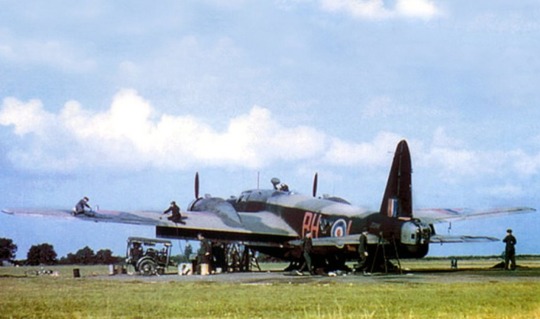
26 March 1942. 300 Polish Squadron Vickers Wellington IV BH-L (Z1269) from RAF Hemswell on a mission to Essen, was shot down over Den Helder by a night fighter flown by Oberleutnant Egmont Prinz zur Lippe-Weissenfeld from 5./NJG 2, all six crewmen killed in action.
@ron_eisele via X
#wellington#vickers Armstrong#bomber#aircraft#royal air force#bomber command#aviation#royal air force aircraft#ww2
14 notes
·
View notes
Note
You asked me a bit ago about my naval plans in my WIP, and the truth is I don't have much, so can I ask for your help in creating some? What sort of shenanigans could a semi-modern navy (think cruisers, battleships, a very few capital class battleships, submarines) get into with officially neutral ports, trade ships, and passenger ships?
I'm thinking most of the naval stuff will involve not the warring major nations, but them fighting over supplies and shipments from other nations. Help me friend!
Well, well, well! Now that is quite the conundrum you've got there, and certainly filled with opportunities for some very interesting scenarios. I'm going to search in my head for some IRL examples of interesting non-total-war uses of naval power in the period, and you can tell me if anything helps!
Here, I've compiled a short list of some interesting naval-related incidents in world history, mostly from the approximate era relevant to Mortal Sparks. I hope they might give some inspiration!
The Tangiers and Agadir Crises: Sea Power, Short Of War
These two incidents, taking place in 1905 and 1911 respectively, were among the defining incidents in European great power politics in the lead up to WW1, and are sometimes touted as possible alternative inciting incidents for what would become the Great War. Both principally concerned the political status of Morocco, but would become stages on which France and Germany would test the influence of themselves and their respective alliances against one another. The naval aspect of the affair was most obviously shown in the second crisis, which saw a German gunboat dispatched to Morocco as a sign of their willingness to back their position with force, soon followed by the gunboat's replacement with a cruiser.
While France, Germany, and the UK would end both crises at the negotiating table, Germany's Kaiser Wilhelm II in particular would feel particularly slighted at having come out on the losing end twice. Meanwhile, France and the UK would solidify their burgeoning entente with the signing of further naval treaties specifying either ally's role in the event of a full war with Germany.
South American Naval Arms Race: Ships For Sale?
This is less an example of great powers competing through the naval domain, and more an example of the shenanigans that great naval powers can be involved in even if they themselves have no intention of firing a shot in anger. Taking the form of a three way competition between Brazil, Chile, and Argentina from the late 19th century and into the 20th, it would see these countries massively expanding their respective navies. However, as none of the three regional powers possessed the industry and infrastructure to construct modern warships themselves, their fleets would be made up of dozens of ships built and designed by foreign, predominantly British, shipyards. The whole crisis would be considerably exacerbated by the creation of HMS Dreadnought, which single handedly rendered all existing battleships practically obsolete and spurred on demand for existing capital ships to be replaced rapidly across the board. In fact, Brazil's own exceptionally ambitious reaction to the affair would lead to it acquiring its own first dreadnoughts, of the Minas Geraes class, before Germany, France, Russia, or Japan would, built by the British companies Armstrong and Vickers, and in many ways superior to the first existing British and American dreadnoughts.
It's also notable that, despite the UK's own yards supplying the ships that manifested this crisis, the British government would repeatedly attempt to defuse tensions in order to preserve its valuable trade relations with the region. Interestingly enough, when WW1 did break out, many of these ordered dreadnoughts would still be under construction in their British yards, and either by seizure or purchase be acquired by the Royal Navy, alongside, interestingly enough, battleships under order for the Ottoman Empire.
Anglo-German Ocean Liner Race: Battles With Bling
An edge example, but I thought it'd be an interesting one since you did mention passenger ships! While the Anglo-German Naval Arms Race gets a lot of attention with its contributions to WW1, a similar competition in the sphere of commercial success and national prestige was playing out between the shipping lines and yards of the two great powers of the early 20th century. Size and luxury substituted firepower and protection when it came to key design features, but speed was of equal importance to both. If I were to make a larger point with this example, it would be that states which can raise and support large navies with the relevant infrastructure, technology, and skilled labour often have sizeable civilian maritime sectors as well. The usage of ocean liners as troop transports, on the other hand, shows how civilian assets in peacetime can be mustered for wartime service.
Beware, Arch deserts from his commitment to sticking to a specific era in the content below. Read at your own risk.
The Altmark Incident: Neutrality Not Withstanding
A touch past the scope of the designated era, and close to being an 'actual' war scenario of the sort I'm supposed to be avoiding, but it's honestly such a fascinating incident that I couldn't not include it. The crisis takes place during the so-called 'Phoney War', a period usually defined as spanning between invasions of Poland and of France and the Low Countries. A crucial point in the events of the crisis, and what ultimately made me decide to include it in this list, was the fact that Norway itself was still a neutral nation at this point, with ties to both Germany and the Western Allies.
The inciting event of the whole incident surrounds the German auxiliary vessel Altmark. Sailing back to Germany from the Atlantic down the coast of Norway, she carried three hundred POWs taken from British shipping by the 'pocket battleship' Graf Spee on her convoy raids. After the latter's destruction, she'd fled British and French naval forces, and at this stage relied on the neutrality of Norway and its territorial waters to safeguard herself and her cargo. A series of events I lack the ability to summarise would occur between the auxiliary and Norwegian authorities, which resulted in Altmark being allowed passage through a specially protected zone of Norwegian waters around Bergen to avoid an international incident.
The British government, finding about the matter via its embassy in Oslo, had other ideas. A force consisting of a light cruiser and five destroyers was immediately dispatched to intercept Altmark. The flotilla would make contact with the auxiliary while she was still under neutral Norwegian escort. The British would make increasingly brazen attempts to isolate Altmark as the collection of ships approached Germany, and when she finally ran out of space to manouevre the German vessel entered a fjord and ran aground on its ice, trapped. The British commander on the scene requested that their POWs be released, his Norwegian counterpart stated that he would refuse any British boarding attempt with force if he had to, and after seeking permission from the Admiralty HMS Cossack stormed into the fjord and, just avoiding a last ditch ramming attempt by the Altmark, boarded the auxiliary and freed the prisoners.
The sheer political fallout from the whole affair was immense. Norway, of course, protested the brazen breach of neutrality that had just taken place, while the UK criticised Norway for allowing a ship carrying POWs to pass through its waters. The applicability of any of these events to your worldbuilding is something I can't predict, but at least it might give you an example of the shit storms that can come about even with neutral states.
The S-363 Incident: Whiskey On The Rocks
If you thought the last example was a strange one, you ain't seen nothing yet! This affair, often referred to as the "Whisky On The Rocks" Incident, is probably one of the most personally fascinating Cold War events I can think of, and with some slight tweaking could fit in with any time period.
The incident centers on the Soviet diesel electric submarine S-363, of a type referred to under NATO terminology as the 'Whiskey' class. Whilst conducting a surveillance mission on a major Swedish naval exercise, the submarine ran aground in Swedish territorial waters. An unarmed Swedish officer was sent to board the boat and question her captain, who blamed serious failures in navigational equipment as reasons why his submarine had traversed numerous fjords and islands to come aground so close to the major Swedish naval base of Karlskrona.
The Soviet captain was removed from the boat for interrogation in the presence of Soviet officials, while Swedish authorities searched the submarine. In the meantime, a sizeable Soviet naval task force was assembled and put to sea in the Baltic, approaching Swedish waters. Using radiological equipment, traces of uranium were found in the boat's torpedo tubes, suggesting the presence of nuclear torpedoes aboard S-363.
A storm swept over the region, leading the grounded submarine to send out a distress signal. Soon afterwards, two unknown vessels were detected entering Sweden's territorial waters from the last known point of the Soviet flotilla, heading straight towards Karlskrona, and the crisis reached its height of tension. Swedish aircraft were armed and ready to strike, and coastal batteries were put on full alert. Finally, it would be revealed that the two vessels were actually a pair of German merchant ships.
The crisis would end ten days later with the return of the submarine to Soviet authorities, but marks one of the most tense periods of the Cold War, a 'conflict' which on the whole saw little open fighting between the major powers involved in it.
#writeblr#worldbuilding#writeblr stuff#guess which eras of history I'm most familiar with!#the answer will not surprise you#sorry but I hope you can find some of this useful in your Worldbuilding!#on the one hand it feels like I'm not doing much beyond summarising some interesting bits of naval history#but at the same time learning about these events is how I've developed my 'instincts' when it comes to creating events in the 12 Worlds#if you'd like more help developing something yourself I'd be happy to help!
6 notes
·
View notes
Text
Efeméride: 22 de mayo de 1962 - transatlántico "Stratheden"
La escala efeméride de hoy es para una postal del transatlántico “Stratheden” de la compañía Peninsular and Oriental Steam Navigation Company (P&O), que un día como hoy de 1962, realizaba una escala al puerto de Barcelona. Procedía de Marsella y a bordo viajaban unos 1.200 pasajeros y que tenían como destino el Reino Unido. El “Stratheden” sería construido por Vickers-Armstrongs en Barrow en…
#22 de mayo de 1962#Efeméride#P&O#Peninsular and Oriental Steam Navigation Company#Puerto de Barcelona#Stratheden#transatlantico
0 notes
Text
Armstrong Whitworth A.W.14 Starling
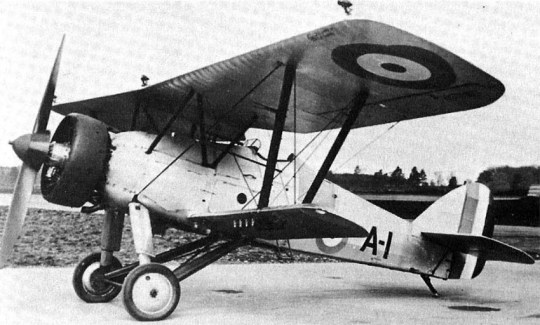
The Armstrong Whitworth A.W.14 Starling was developed to meet the requirements of Specification 28/24, for a single-seat fighter capable of operating in day and night-time conditions to replace Armstrong Whitworth’s earlier Siskin. Armament was two synchronised .303 in Vickers machine guns.
Two prototypes were ordered, with the first J8027, powered by a 385 hp (287 kW) Armstrong Siddeley Jaguar VII radial engine flying on 12 May 1927. It proved to be underpowered with this engine, and was therefore re-engined with a 460 hp (340 kW) Jaguar V engine. Performance was still unimpressive however, with the first prototype not exceeding speeds of 160 mph (260 km/h) rather than the expected 180 mph (290 km/h), while low speed handling was poor. The prototype was evaluated against the later Specification F.9/26 in February 1926, but was rejected by the RAF, who instead selected the Bristol Bulldog. J8027 was returned to Armstrong Whitworth, who fitted it with new wings with Clark YH aerofoil section and leading edge slots fitted on the upper wings. It was given the civil registration G-AAHC in May 1929, and was shown at Olympia in London in July 1929. It was cancelled from the register in December 1930.
The second prototype, J8028 was heavily redesigned, with a more streamlined fuselage and revised wings, which although retaining the Clark YH aerofoil section, had smaller lower wings. It was powered by a 525 hp (391 kW) Armstrong Siddeley Panther II engine, first flying on 5 December 1929. It was evaluated as both a land-based interceptor against Specifications F.9/26 and F.20/27 and as a naval fighter to meet the requirements of Specification N.21/26. While showing better performance than the first prototype, it too was unsuccessful.
More photos here.
0 notes
Text
The manufacturing history of Preston and other Lancashire cotton towns.
Richard Arkwright, the father of the factory system, was born in Preston on 23 December 1732. He became obsessed with the idea of spinning yarn mechanically. This was with reason, for a single loom could absorb the output of a half dozen spinners. Two centuries later a Preston engineer was chosen by Vickers-Armstrong to manufacture thousands of aircraft for the coming war. Preston, like much of…
#Aircraft#British#Cotton#Engineering#First factory#Flying shuttle#Industrial Revolution#manufacturing#Spinning jenny#Steam#Textiles
0 notes
Text
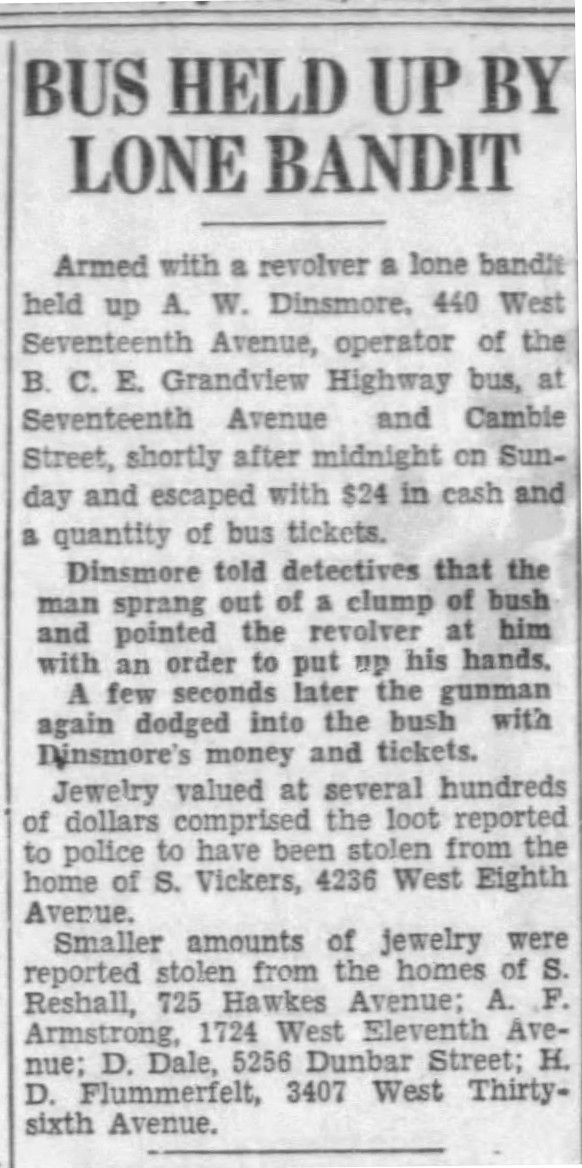
"BUS HELD UP BY LONE BANDIT," Vancouver Sun. July 3, 1934. Page 2. --- Armed with a revolver a lone bandit held up A. W. Dinsmore, 440 West Seventeenth Avenue, operator of the B. C. E. Grandview Highway bus, at Seventeenth Avenue and Cambie Street, shortly after midnight on Sunday and escaped with $24 in cash and a quantity of bus tickets.
Dinsmore told detectives that the man sprang out of a clump of bush and pointed the revolver at him with an order to put up his hands. A few seconds later the gunman again dodged into the bush with Dinsmore's money and tickets.
Jewelry valued at several hundreds of dollars comprised the loot reported to police to have been stolen from the home of S. Vickers, 4236 West Eighth Avenue.
Smaller amounts of jewelry were reported stolen from the homes of S. Reshall, 725 Hawkes Avenue; A. F. Armstrong, 1724 West Eleventh Avenue; D. Dale, 5256 Dunbar Street; H. D. Flummerfelt, 3407 West Thirty-sixth Avenue.
#vancouver#armed robbery#armed robber#gunman#stolen jewelry#crime wave#great depression in canada#crime and punishment in canada#history of crime and punishment in canada
0 notes
Video
youtube
Herseaux, Belgium May 1940 A Vickers Armstrong light tank crosses the b...
0 notes


